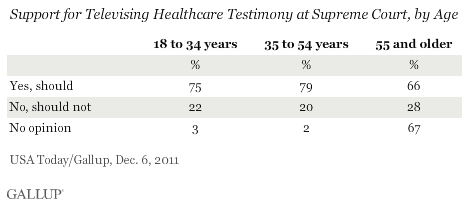PRINCETON, NJ -- Nearly three-quarters of Americans, 72%, think television cameras should be allowed into the U.S. Supreme Court when it hears oral arguments in its upcoming review of President Barack Obama's healthcare law.

These are Americans' basic reactions to courtroom cameras when asked a question that does not provide the pro and con arguments on the issue. These findings are from a USA Today/Gallup poll conducted Dec. 6.
Americans show broad bipartisan agreement on the question, although support for introducing cameras into the high court is slightly higher among Republicans than Democrats, 77% vs. 70%. At 66%, moderates are slightly less in favor than either conservatives (78%) or liberals (75%).
Although Americans of all major age groups generally favor allowing the healthcare case to be televised, support is lower among adults 55 and older -- those most likely to be aware of the tradition and arguments against courtroom cameras -- than those younger than 55.

Last month the U.S. Supreme Court agreed to rule on the constitutionality of President Obama's healthcare law to settle the legal challenges several states have brought. C-Span immediately asked the Supreme Court to break its long-standing prohibition on television cameras in the courtroom and allow it to cover the five-and-a-half hours of scheduled testimony in the case. While the Supreme Court has traditionally decided on its own whether to admit cameras, the Cameras in the Courtroom Act of 2011, if passed, would require it. Congress recently held hearings on the issue, with leaders from both parties expressing support for televised proceedings.
Americans widespread support for televising testimony in the healthcare case is greater than what Gallup found in December 2000 when asking about the Supreme Court's ban on cameras, in general. At that time, a bare majority of Americans, 50%, said the court should allow television coverage when they hear arguments; 48% said it should not.
As for Americans' views on the healthcare law itself, Gallup recently found 47% in favor of repealing it and 42% wanting it maintained.
Implications
How the Supreme Court rules on the legality of President Obama's healthcare law will have significant economic and political ramifications for the country, in addition to the effect it will have on the healthcare of individual Americans. C-Span Chairman Brian Lamb has argued that the importance of the case demands that Americans receive the most direct access possible to the lengthy oral testimony. And while the Supreme Court will likely get to decide this matter itself before the hearings take place in March, rebuffing Congress and public opinion could fuel the movement afoot in Congress to pass a law requiring the Supreme Court to permit cameras. In turn, that would likely set off a major constitutional challenge of its own between Congress and the high court.
Survey Methods
Results for this USA Today/Gallup poll are based on telephone interviews conducted Dec. 6, 2011, with a random sample of 1,011 adults, aged 18 and older, living in the continental U.S., selected using random-digit-dial sampling.
For results based on the total sample of national adults, one can say with 95% confidence that the maximum margin of sampling error is ±4 percentage points.
Interviews are conducted with respondents on landline telephones and cellular phones, with interviews conducted in Spanish for respondents who are primarily Spanish-speaking. Each sample includes a minimum quota of 400 cell phone respondents and 600 landline respondents per 1,000 national adults, with additional minimum quotas among landline respondents by region. Landline telephone numbers are chosen at random among listed telephone numbers. Cell phone numbers are selected using random-digit-dial methods. Landline respondents are chosen at random within each household on the basis of which member had the most recent birthday.
Samples are weighted by gender, age, race, Hispanic ethnicity, education, region, adults in the household, and phone status (cell phone only/landline only/both, cell phone mostly, and having an unlisted landline number). Demographic weighting targets are based on the March 2010 Current Population Survey figures for the aged 18 and older non-institutionalized population living in U.S. telephone households. All reported margins of sampling error include the computed design effects for weighting and sample design.
In addition to sampling error, question wording and practical difficulties in conducting surveys can introduce error or bias into the findings of public opinion polls.
Polls conducted entirely in one day, such as this one, are subject to additional error or bias not found in poll conducted over several days.
View methodology, full question results, and trend data.
For more details on Gallup's polling methodology, visit www.gallup.com.
